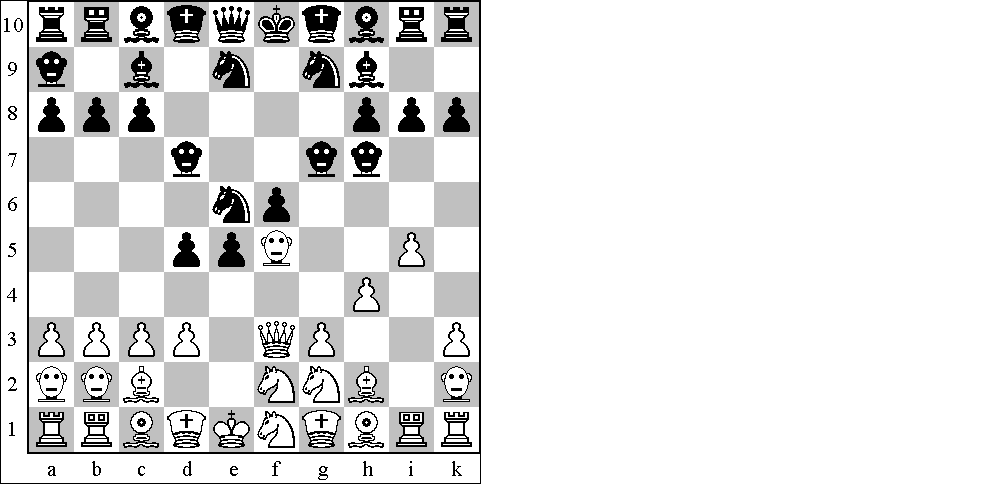Duke of Wellington
Waterloo 百田棋 (the chess variant)
(3rd edition)
Kosintsev I.G.
kosintsev.i.g@gmail.com
(26.12.2015)
Hello chess players! I continue to go with the chess evolution and had gone via Avant-garde Grand chess to the more perfect chess variant titled “Waterloo”.
This 100-squares chess variant has wide strategic and tactical possibilities but at the same time is using an extended set of the chess pieces with the traditional style of movement well known to all chess players. Pieces are arranged hierarchically and harmonically at the initial position.
The initial (in agree with etiquette centre-symmetrical) position at the game Waterloo with the 10x10 board is follows.
White:
1. (P) Pawn: a3, b3, c3, d3, e3, f3, g3, h3, i3, k3.
2. (N) Knight: d2, e2, f2, g2.
3. (G) Guard: a2, b2, k2, 8i2.
4. (B) Bishop: c2, h2.
5. (C) Cardinal: c1, h1.
6. (R) Rook: a1, k1.
7. (M) Marshal: b1, i1.
8. (A) Adviser: d1, g1.
9. (Q) Queen: f1.
10.(K) King: e1.
Black:
1. (P) Pawn: a8, b8, c8, d8, e8, f8, g8, h8, i8, k8.
2. (N) Knight: d9, e9, f9, g9.
3. (G) Guard: a9, b9, k9, i9.
4. (B) Bishop: c9, h9.
5. (C) Cardinal: c10, h10.
6. (R) Rook: a10, k10.
7. (M) Marshal: b10, i10.
8. (A) Adviser: d10, g10.
9. (Q) Queen: f10.
10.(K) King: e10.
The hieroglyphic japanesque design is more simple and convenient for game.

Rules:
1. The orthogonal mode of the movement O or O(n), where n is the number of the path cells.

2. The diagonal mode of the movement D or D(n), where n is the number of the path cells.

3. The neighbor mode of the movement N or N(n), where n=1,2,3 over the neighbor occupied or unoccupied squares (Jump).

1. (P) The pawn moves without the capture by O(1) mode or with the capture by D(1) mode.
Pawn may advance in its first ahead move, without capturing, by O(2) mode.
The pawn may standard capture «en passant».
The pawn that reaches the eighth promotion row can (at the player's disire) promote or not promote for spy moving by N(1) mode. The pawn that reaches the ninth and last promotion row can (at the player's disire) promote or not promote for the piece (except King) corresponding to this row at the initial position.
2. (N) The knight moves by N(3) mode.
3. (G) The guard (pasha or mastodon) jumps by N(1) or N(2) modes.
4. (B) The bishop moves by D mode.
5. (C) The cardinal combines the powers of the bishop and knight.
6. (L) The rook moves by O mode.
7. (M) The marshal combines the powers of the rook and knight.
8. (A) The adviser moves by O or D modes.
9. (Q) The queen (Amazonka) combines the powers of the adviser and knight.
10. (K) The king moves by N mode during the game, provided that he hasn't been checked before he makes his move. It loses the right to make N(2) and N(3) moves after the check and moves only by N(1) mode.
Castling doesn't exist (compare with Chaturanga [3]).
Other rules of this game are identical with rules of classical chess [1].
Internet resources:
1. Chess.
http://en.wikipedia.org/wiki/Chess
2. Chess.com.
http://www.chess.com/
3. Chaturanga.
http://www.chessvariants.org/historic.dir/chaturanga.html
4. Omega Chess.
http://susanpolgar.blogspot.com/2007/08/omega-chess.html
5. Wikipedia, the free encyclopedia. Grand chess.
1 http://en.wikipedia.org/wiki/Grand_chess
6. Archchess.
http://www.chessvariants.com/historic.dir/arch.html
7. Pacific Chess.
http://www.chessvariants.com/large.dir/pacific.html
8. Mideast Chess.
http://www.chessvariants.com/large.dir/mideast.html
9. Mastodon Chess (10x10).
http://hem.passagen.se/melki9/mastodon.htm
10. Modern Grand Chess.
http://chess-checkers-go.blogspot.com/2010/02/modern-chess.html
11. Avant-garde Grand Chess.
http://chess-checkers-go.blogspot.com/2013/02/avant-garde-grand-chess.html

















